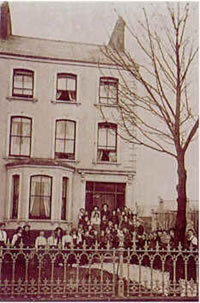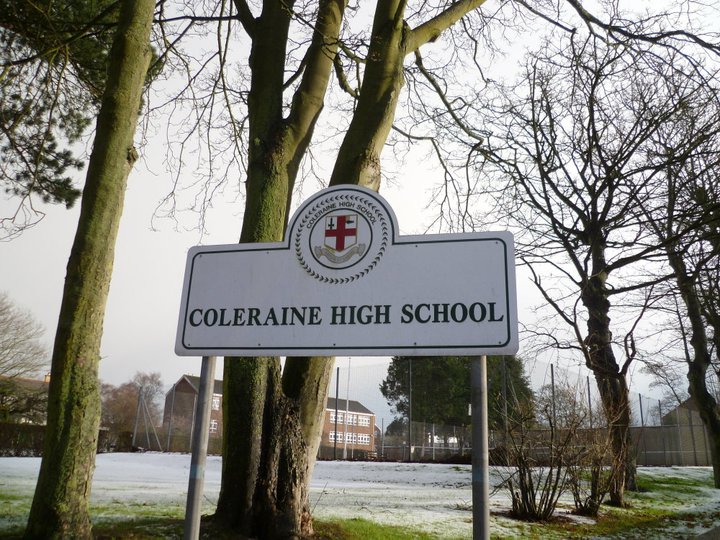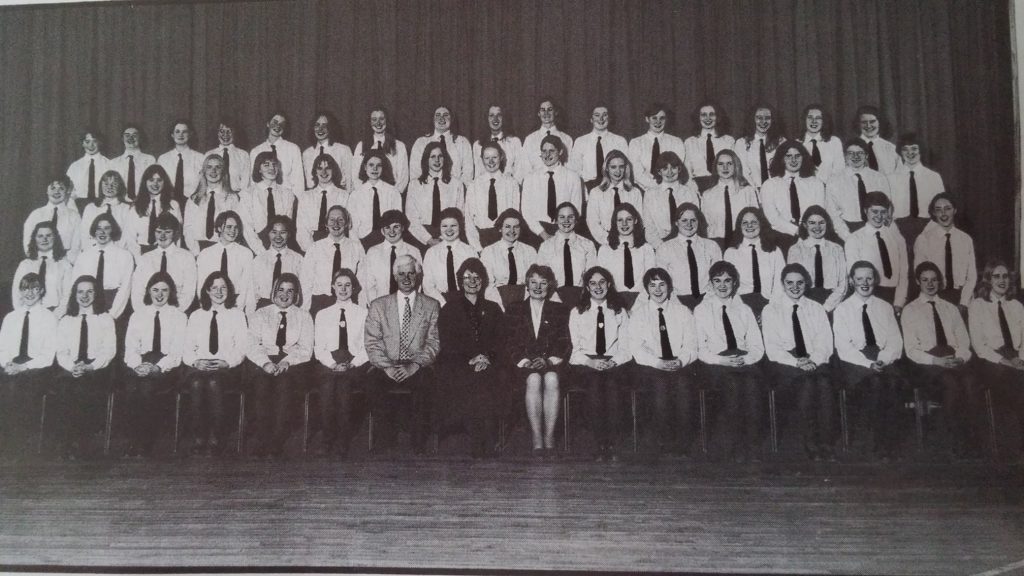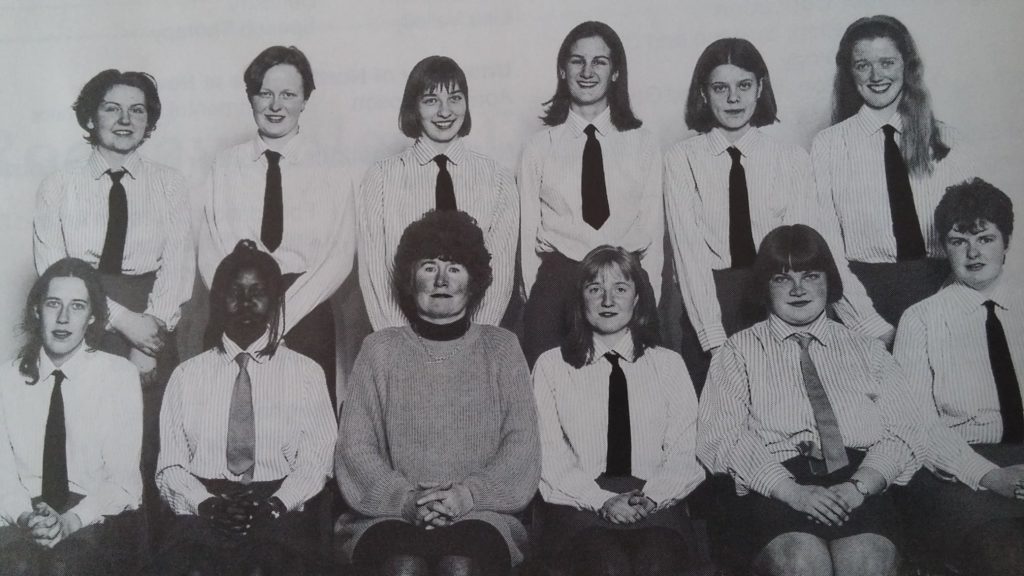The History Of Coleraine High School
So began the official history of Coleraine High School, the second oldest girls’ school in Northern Ireland.

Mrs. Long who founded the school in Alexandra Terrace, Railway Road, in which her daughters were teachers, was the widow of Rev. Andrew Long of Monreagh Presbyterian Church, Co. Donegal. She called her school “Gordonville School” in honour of her mother whose maiden name was Gordon, and, from its earliest days, it took both boarding and day pupils. The first pupil at Gordonville School was a girl called Milligan whose first name, unfortunately, is unknown. Her younger sister, Matilda, became a pupil in 1875 at the tender age of three! Mrs. Long first moved her school to Waterford Terrace in Lodge Road and then, in 1880, to the new premises on the other side of the Lodge road which formed the main teaching block until 1966 and continued to be the boarding Department until the mid-1980s. This site has since been redeveloped for private housing but retains the old name “Gordonville”.
The Misses Long married and left the area and, in 1894, Mrs Long retired and sold her school to the Misses Irwin. These ladies appear to have had a great interest in music and the local press records many concerts which they organised in the 1890’s including at least one on behalf of ‘Culrathian’, in a society which raised funds for Coleraine Academical Institution, the local school for boys!Academically, the school was progressing, and in 1895 the ‘Coleraine Chronicle’ offered its congratulations to the Misses Irwin in the school’s examination results. In that year, for example, Mary B. Mackey gained entrance to the Royal University of Ireland and entrances to Queen’s College, Belfast, are mentioned in subsequent years. Pupils of “Gordonville Ladies’ School” were amongst the first to be granted degrees from Queen’s on the same basis as men when the rules of the college were changed in 1879.
In 1898 a local, Margaret E. Tannahill, gained an Arts degree from the Royal University of Ireland and in 1902, she bought Brynderwyn School, Coleraine, from Miss Warnock. In 1903 the same Miss Tannahill became Headmistress of Gordonville Ladies’ School, and it would appear that she united the two schools on the Gordonville site. By that time the school had 9 staff and about 10 pupils of whom five were boys in the “Children’s School”.
Old House

Interestingly, however, before the demolition of “Gordonville” in the mid 1980’s an old brass plaque bearing the inscription “The High School” was removed from the railings outside the buildings and, on the reverse was etched “Gordonville Ladies’ School”!
Miss Scott was owner of the school until 1923 when a Board of Governors was appointed, and she continued as Headmistress until her retirement in 1937. One of the features of the school was that girls were taught science in the Technical College which, at that time, was sited on Lodge Road. A fair number of pupils gained degrees in science, even in those early years, and the number gaining arts and medical degrees was also creditable.
The girls played their part in the “war effort” between 1914 and 1918. They knitted socks for and sent food parcels to the prisoners of war, and concerts were held to raise funds. Each Saturday in the summer each pupil walked to Portstewart.
From the 1920s onwards, the school began to take on a more “modern” appearance. School uniform became compulsory- the mainly bottle green colours and blazers of the school uniform remaining unchanged until the school was closed on 31 August 2015.
As early as 1929 the Board of Governors discussed plans for building a completely new school on a different site, but, until that could be done, temporary premises were built behind the existing school. This “New Wing” costing £3,369 was opened on 1st December 1930 and was used until the closure of the Preparatory Department in 1977.
In 1937 Miss Scott retired. Feminists of today may not be impressed with her favourite “text” – “to be a happy wife and mother is a woman’s highest function; to be useful, successful, contented, though unmarried, an uncommonly good second”.
The War Years
Miss Scott’s successor was Dr Elsie Johnston, who was headmistress from 1937 to 1959.
The Second World War left its mark on the school with numbers of pupils increasing as evacuees came from London, Manchester and Belfast. The tennis courts were dug up and vegetables were planted to help the war effort; the old kitchen in the basement was converted into an air-raid shelter and, under the tuition of Mr May, some girls were taught the skills of marksmanship.
In 1943 the first Northern Ireland Training for the Girls’ Training Corps was formed in Coleraine High School and the Technical College. Dr Johnston was the Commandant, and the Adjutant was Winfred Greeves, later the headmistress of Glenlola Collegiate School. Towards the end of the war Dr Johnston met a handsome English RAF officer, billeted in Coleraine who ‘swept her off her feet’. They were able to marry at the end of the war, judicious saving and borrowing of ration coupons permitting, and she became Mrs. Andrew Brown!
Continued Expansion
After the war the school continued to grow and among other additions to accommodation, a new laboratory was equipped. In 1951 the school became a Voluntary School under the terms of the 1947 Act, a move reluctantly accepted by the Governors. In 1953 “Spring Gardens”, a private residence with considerable grounds on the Lodge Road was purchased with the intention of developing it as the site for the new school buildings. Work on an Assembly Hall and canteen began in 1959, just prior to the retirement of Dr Johnston and to the school becoming a County Grammar School, under the Co. Londonderry Education Committee. The last act of the old Board of Governors was to appoint Dr Johnston’s successor, Miss M.W. Lillie. By that time there were 460 pupils in what was now called Coleraine High School and the facilities had many shortcomings. By the autumn of 1966 a completely new building on the Spring Gardens site was ready for occupation. For a time, two rooms in that building were used as offices for the Vice Chancellor of the New University of Ulster.
In the years that followed, the curriculum developed and widened to meet the needs of growing numbers of girls eager to pursue academic careers. The school flourished and pupil numbers increased requiring further expansion as the school was becoming cramped for space/overcrowded/ less fit for purpose again.
The first extension was completed in early 1972 followed by a new, larger, Assembly hall completed in time for the Centenary celebrations in 1975. Two houses adjacent to the school, Nos. 38 and 40 Lodge Road, were adapted for use as a Sixth Form Centre and a further extension to the Boarding Department. The biggest change in these years was the increasing number of pupils staying to take “A” levels, many of whom then proceeded to third level education. Miss Lillie retired in December 1973 and was succeeded by Miss E.J. Duffin, the seventh headmistress in 100 years. During the Centenary celebrations in the school year 1974-1975, Dr Johnston and Miss Lillie were among the special guests and made valuable contributions to the proceedings. Miss Duffin, who was headmistress from 1974 until 1987, led the school into the computer and technology age without losing sight of the good academic grounding for which Coleraine High School was well known.
Achievements in the academic world, in the arts and in sport continued under the eighth headmistress, Mrs D. Hutchieson. With almost 120 years’ experience, this was clearly a school where “parents who are anxious to procure a thorough education for their children will find advantages rarely to be met with” (quoted directly from the advertisement above).
The final chapter -2005 to 2015
Pleasantly located on a 28-acre site adjacent to the town, Coleraine High School remained a controlled Grammar School providing a bright, modern environment for nearly 800 girls until 2015. Sadly, the Boarding School was closed in June 1997 due partly to the decrease in demand for boarding, but mainly to the fact that the number of places afforded to local pupils was increased. The Boarders’ accommodation, known as Spring Gardens was quickly redeployed for other school uses, primarily Art and Music. In February 2012, however, Spring Gardens had to be demolished following the decision by the NEELB that it posed a health and safety risk due to a variety of problems including dry rot.
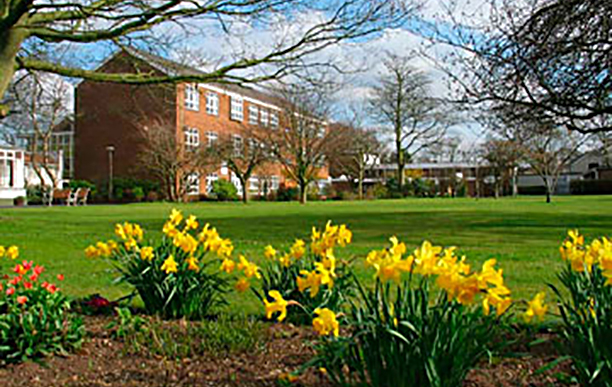
Mrs Anne Bell became the ninth and final Headmistress of Coleraine High School in 2005. She had the task of steering the school through changing times, when the political impetus was to end academic selection within the education system and the demographic decline of the school age population in the local area.
The academic record of the school was always fairly impressive. For example, in 2010, it is reported that 99% of girls achieved grades A*- C in five or more subjects at G.C.S.E, while at ‘A’ level 90% had three or more subjects at A/C. These achievements placed Coleraine High School 24th in the UK and the top state school in Northern Ireland in the Sunday Times listing of high performing schools.
More and more girls decided to remain in school after GCSE and the majority of them followed this up by going to Universities or Colleges of Higher Education on completion of their Sixth Form studies. The trend was that an increasing number followed science, engineering and business/language courses. Though all schools are required to follow the requirements of the Common Curriculum, Coleraine High School provided the opportunity for girls to develop their own individual strengths, abilities and interests while maintaining the breadth, balance and relevance in its curricular provision.
While a conformity to the school motto ‘Virtute et Labore’ (by strength of character and diligence) was expected, another aspect which was given much attention was the happiness or the well-being of individuals. It is reasonable to assume that if people are unhappy then they will not be capable of their best performance. If, on the other hand, they feel that they are a part of a caring environment then the quality of their work will be higher. The pupils involved in the school Environmental Society promoted respect and care for the school’s surroundings and they, together with the hard-working caretakers and ground maintenance staff, were responsible for winning the Best Kept Large School award on no less than six occasions.
The effects of ‘all work and no play’ were considerably reduced by the provision of a vast range of extra-curricular activities. In addition to drama, public speaking, debating, Scripture Union, Scientific Society, Modern Language Society, Duke of Edinburgh’s Award Scheme, Pony Club and the school’s own Guide Company, there was always a full range of sporting activities, These included hockey, badminton, harriers, athletics, tennis and golf.
Music featured strongly throughout the school’s life and as well as junior and senior choirs there was a fine School orchestra. Peripatetic tuition was provided by the North-Eastern Education and Library Board in woodwind and strings and private tuition was also available. Each year high quality public productions and performances allowed these young musicians, dancers and actresses to display their talents and work as a team while just as much was learned by those who were responsible for make-up, props. or costumes.
widening of horizons
Many charities benefited financially from activities organised by pupils. They selected the groups they wished to support whilst discovering more about the organisations and their work. It was recognised however, that while learning to give and share is very important, so too is the need to learn, to understand and respect the views and cultures of others. Education for Mutual Understanding played a significant part in the life of the school for, in addition to frequent organised meetings with young people from seven other secondary schools in the area, a close link was developed during the latter years of CHS with a similar school in Dublin. Letter writing and exchange visits helped to highlight the fact that there was more features in common than differences.
A widening of horizons was continually being encouraged. Coleraine High School was linked with schools in La Roche sur Yon in France and Ulm in Germany. Visitors from these different countries came to stay with families in the area while sharing in the school’s activities.
Pupils from Coleraine High School also made frequent visits to the continent. The school enthusiastically engaged with a Young Enterprise Scheme. This type of programme involved setting up a company, appointing a Chairman, Directors and managers, issuing shares, holding properly constituted meetings and so on. The aim was for the company to identify a market for the product, make the product and then sell it with a view of making profit for its shareholders, in this case, the pupils! The Young Enterprise Scheme involved drawing on the expertise of ‘Advisors’ from business and industry. Similar contributions were welcomed by the Careers and Guidance Departments for insight into Industry days and for talks about specific areas of employment. Many companies provided opportunities for work experience. Such involvement by members of our local community was highly valued and much appreciated.
Staying in touch after leaving school now that the school has closed is not a problem, as the Old Girls’ Association provides opportunities for all former pupils to come together for various social occasions. As well as a Coleraine group, there is also a very well supported Belfast branch of the Association.
A new Co-Educational Grammar School for Coleraine
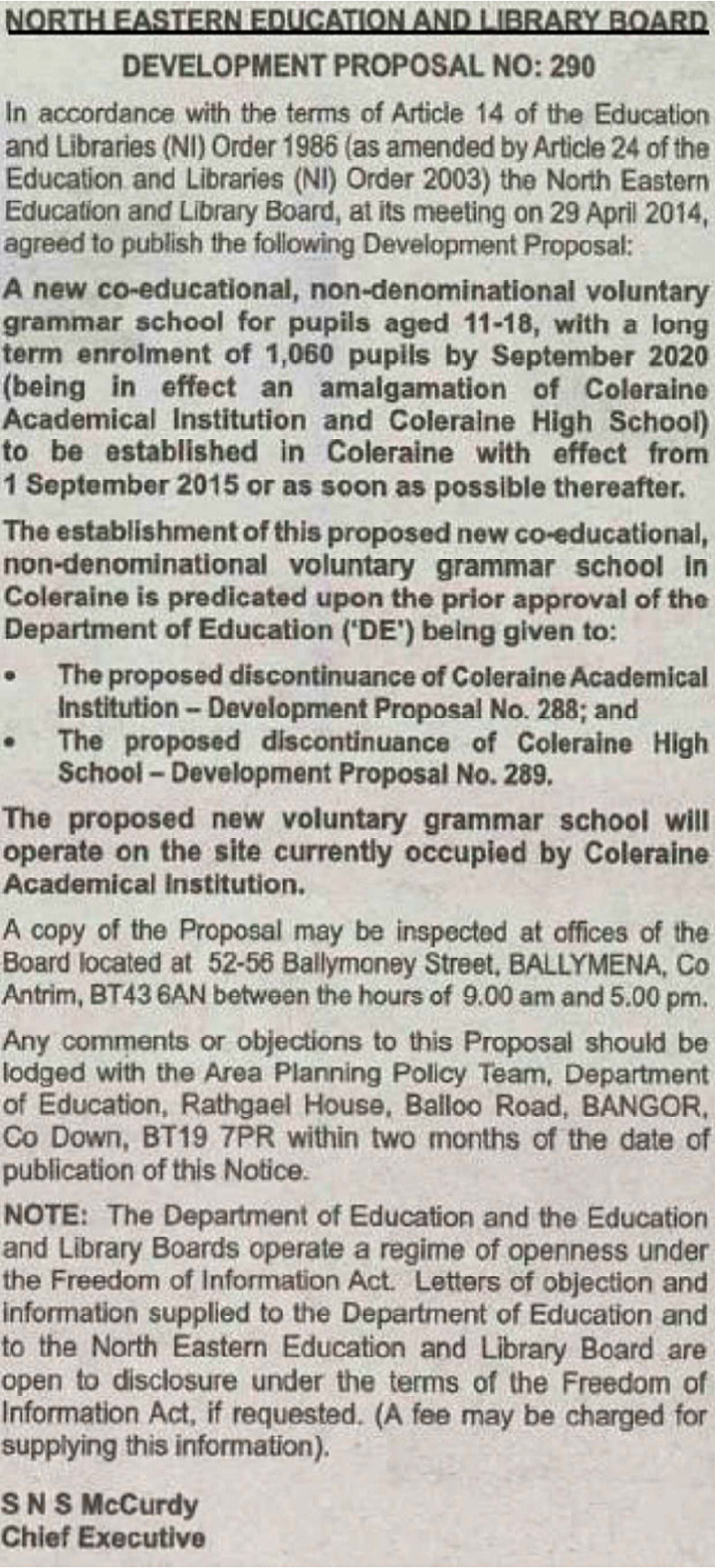
In the end, as a consequence of the Area Planning Development Proposals approved by the Minister for Education in NI, John O’Dowd, on 26th September 2014, the closure of both Coleraine High School and Coleraine Academical Institution was decided upon. The NEELB made the following recommendation to the Minister, ultimately with the support of the three schools, which included Coleraine College-
- the demographic downturn and its impact currently and into the future on schools;
- the strongly expressed desire for ‘grammar school’ education in Coleraine;
- the current enrolment pattern at the schools;
- the impact of parental choice (particularly on Coleraine College given the number of grammar places available);
- the impact of parental choice (particularly on Coleraine College given the number of grammar places available);
- an expressed desire for co-educational schools;
- an expressed desire for co-educational schools;
- the need to improve school performance, particularly given current performance of Coleraine AI and Coleraine College;
- the need to improve school performance, particularly given current performance of Coleraine AI and Coleraine College;
- the pattern of under-subscription to Coleraine AI and Coleraine College;
- the need to secure future post primary provision which is sustainable and viable;
- the provision of appropriate educational pathways for pupils.
final approved Development Proposal

The crest of Coleraine Grammar School contains the colours, symbols and founding dates of both schools, along with the founding date for CGS.
The new uniform also incorporates styles, colours and elements of the original schools’ uniforms, from the Inst striped blazer which includes CHS red and green, to the ties which are worn at various stages of pupils’ progress through the school, in red, green and navy.
But, most importantly, the combination (“amalgamation”) of the staff and the pupils who transferred from both, to the new school in September 2015, brought the values and vision of those schools into a mix of old and new, progress and tradition, and enthusiasm for continuing the best of both with the hope for the future.
The new school already boasts an impressive museum for Coleraine Inst memorabilia, and over the next few years the CHS museum will be developed as part of this. It will be a feature on the Castlerock Road site, to complete the “unification” of 2 historic schools into the new, as the school consolidates on one site and finally leaves the Lodge Road.

